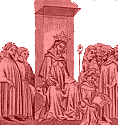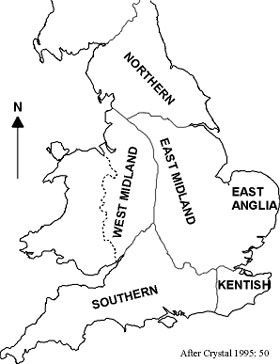

 |
|
 |
| "The Middle English period (1150-1500) was marked by momentous changes in the English language, changes more extensive and fundamental than those that have taken place at any time before or since. Some of them were the result of the Norman Conquest and the conditions which followed in the wake of that event. Others were a continuation of tendencies that had begun to manifest themselves in Old English. … At the beginning of the period English is a language that must be learned like a foreign tongue; at the end it is Modern English." (Baugh and Cable, 1993: 154) |
In relation to the Conquest, Burnley (2000) suggests that innovations linked to the birth of Middle English were only broadly related to the arrival of the Norman French. He claims that, in many instances, dialect manuscripts of the period merely reveal that diversity and change was already occurring in Old English, a result of the substantial linguistic influence of the Scandinavian invaders in the 9th and 10th centuries.
Furthermore, Baugh and Cable (1993) observe that these changes were not only phonological but also grammatical and lexical. However, such changes did not all occur all at the same time but materialized over hundreds of years and at disparate rates in the different Middle English dialects (see below).
Features of Middle English
Burrows and Turville-Petre (1992) highlight three features which specifically distinguish Middle English from Old English:
Middle English Dialects
The accepted dialect divisions of this new form of English (see map) equate approximately with those of Old English. However, Northumbrian is now designated "Northern" whilst Mercian is described in terms of either the "East Midlands" or "West Midlands" dialect. The suggestion is that the majority of the inhabitants of Yorkshire would have spoken the Northern form but that West Riding speech would have belonged to the West Midlands group. Barber (1993) adds that Northumbrian, due in part to political division, separated into northern English and the English of the Scots.
 |
In relation to these dialects Baugh and Cable (1993) observe that diversity was not confined only to the spoken word. Because there was no written standard, people wrote in the dialect employed in their everyday speech. This not to say that they were unaware of the existence of other dialects. There are recorded instances of written works being transcribed from one Middle English dialect to another. For example, the author of the Cursor Mundi, who was from the North, translated the Assumption of Our Lady from Southern English into his own dialect for the benefit of "northern people who can read no other English" (Baugh and Cable, 1993: 184).
The North / South Divide
The features that distinguish northern dialects from those of the south
are, to varying degrees, pronunciation, inflection and vocabulary. Crystal (1995),
citing manuscripts written during this period as evidence for regional speech
differences, provides the following examples of a north \ south linguistic divide:
The Rise of Standard English
Crystal (1995: 50) draws attention to the evolution and adoption of the London dialect (the precursor of Standard English) as the language of the educated, and how its spread throughout the country was aided by the advent of the printing press (when Caxton and his successors adopted London English as the norm for their publications).
Baugh and Cable (1993) expand on this theme of standardization stating that, towards the end of the 14th century, out of the variety of dialects, a written language arose which in the following century gained general recognition and became the acknowledged standard in both writing and speech. The basis for this standard was the English of the East Midlands, particularly the London dialect. There were several factors which led to the predominance of this dialectal form:
Baugh and Cable (1993) also refer to the influence of Chancery English.
Chancery English
Burnley (2000) describes Chancery English as the written form of the language employed by scribes preparing official documents from around the beginning of the 15th century. He adds that although it was a type of London English, dialectally its attributes were not preponderantly southern. Rather, it was distinctively central and east Midland in its character. Burnley claims that its wide adoption was "partly as a result of its status as an official language, partly from the volume of documents written in it, and partly from the acceptability of the dialectal mixture from which it was composed." (2000: 141). Inter alia, within the system:
Baugh and Cable (1993) note that, by the second half of the 15th century, the written form of this variety of English had been adopted in most parts of the country. This, more than any other factor (coupled with Caxton's employment of the London standard), guaranteed the prompt espousal of a standard written form. However, dialectal diversity continued to exist in everyday speech.
Sources
Barber, C. (1993) The English language: a historical introduction, Cambridge: Cambridge University Press.
Baugh, A.C. and Cable, T. (1993) A History of the English Language, Fourth Edition, London: Routledge.
Burnley, D. (2000) The History of the English Language: a source book, Second Edition, London: Longman.
Burrows, J. A. and Turville-Petre, T. (1992) A Book of Middle English, Oxford: Blackwell.
Crystal, D. (1995) The Cambridge Encyclopedia of the English Language, Cambridge: Cambridge University Press.